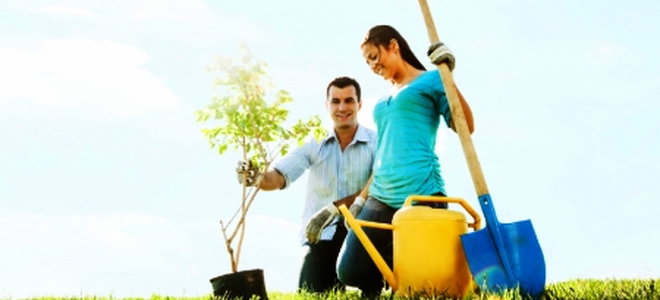Written by Admin and published on https://www.doityourself.com/
Trees make our world a beautiful place. They provide us with many lasting benefits – shade, privacy, increased property value, shelter and food, and they contribute to our mental well-being.
Planting trees is one small way each of us can help improve the environment. Tree planting is easy if you follow these simple steps and remember to “keep the green side up!”
Tree Planting – How to Plant Your Trees

A properly planted and maintained tree will grow faster and live longer than one that is incorrectly planted. Late summer or early fall is the optimum time to plant trees in many areas. This gives the tree a chance to establish new roots before winter arrives and the ground freezes. When spring arrives, the tree is ready to grow. The second choice for planting is late winter or early spring. Planting in hot summer weather should be avoided. Planting in frozen soil during the winter is difficult and tough on tree roots. When the tree is dormant and the ground is frozen, there is no opportunity for the growth of new roots.
Planting Tree Types
Trees are purchased as container grown, balled and burlapped (B&B), or bare root. Generally, container grown are the easiest to plant and successfully establish in any season, including summer. With container grown stock, the plant has been growing in a container for a period of time. When planting container grown plants, little damage is done to the roots as the plant is transferred to the soil. Container grown trees range in size from very small plants in gallon pots up to large trees in huge pots.
B&B plants frequently have been dug from a nursery, wrapped in burlap, and kept in the nursery for an additional period of time, giving the roots opportunity to regenerate. B&B plants can be quite large.
Bare root trees are usually extremely small plants. Because there is no soil on the roots, they must be planted when they are dormant to avoid drying out. The roots must be kept moist until planted. Frequently, bare root trees are offered by seed and nursery mail order catalogs or in the wholesale trade. Many state operated nurseries and local conservation districts also sell bare root stock in bulk quantities for only a few cents per plant. Bare root plants usually are offered in the early spring and should be planted as soon as possible upon arrival.
Carefully follow the planting instructions that come with your tree. If specific instructions are not available, follow these tips:
Utilities – Before digging, call your local utilities to identify the location of any underground utilities.
Hole Size – Dig a hole twice as wide as, and slightly shallower than, the root ball. Roughen the sides and bottom of the hole with a pick or shovel so that roots can penetrate the soil.
Root Prep – With a potted tree, gently remove the tree from the container. Lay the tree on its side with the container end near the planting hole. Hit the bottom and sides of the container until the root ball is loosened. If roots are growing in a circular pattern around the root ball, slice through the roots on a couple of sides of the root ball. With trees wrapped in burlap, remove the string or wire that holds the burlap to the root crown. It is unnecessary to completely remove the burlap. Plastic wraps must be completely removed. Gently separate circling roots on the root ball. Shorten exceptionally long roots, and guide the shortened roots downward and outward. Root tips die quickly when exposed to light and air, so don’t waste time.
TIP: Our expert gardening advisor, Susan Patterson reminds you, “Keep bare root trees moist until planting.”
Planting – Place the root ball in the hole. Leave the top of the root ball (where the roots end and the trunk begins) 1/2 to 1 inch above the surrounding soil, making sure not to cover it unless roots are exposed. For bare root plants, make a mound of soil in the middle of the hole and spread plant roots out evenly over mound. Do not set trees too deep. As you add soil to fill in around the tree, lightly tamp the soil to collapse air pockets, or add water to help settle the soil.
TIP: Susan suggests, “Have someone hold the tree straight while you backfill the hole.”
Form a temporary water basin around the base of the tree to encourage water penetration, and water thoroughly after planting. A tree with a dry root ball cannot absorb water; if the root ball is extremely dry, allow water to trickle into the soil by placing the hose at the trunk of the tree.
TIP: Susan advises, “Be careful not to plant the tree too deeply as it will interfere with oxygen transfer and healthy root development.”
Mulching – Mulch around the tree. A 3-foot diameter circle of mulch is common.
Staking – Depending on the size of the tree and the site conditions, staking may be beneficial. Staking supports the tree until the roots are well established to properly anchor it. Staking should allow for some movement of the tree. After trees are established, remove all support wires. If these are not removed they can girdle the tree, cutting into the trunk and eventually killing the tree.
Original post here https://ift.tt/3gmRDeZ.
from AAA Tree Lopping Ipswich https://ift.tt/3gp75aw
via IFTTT
No comments:
Post a Comment